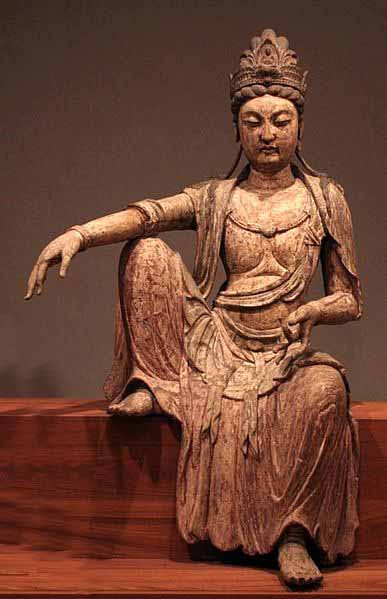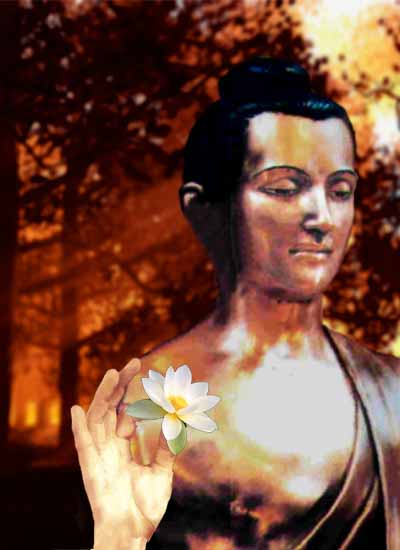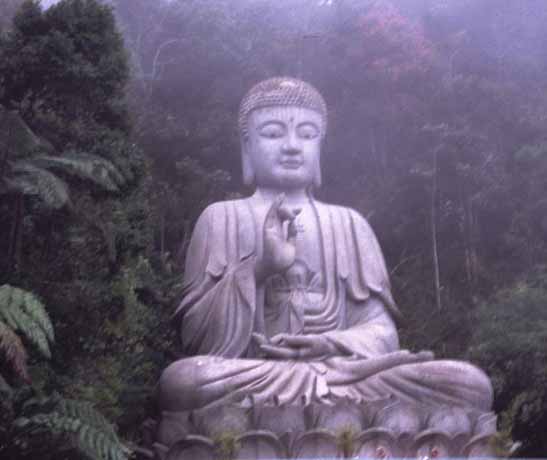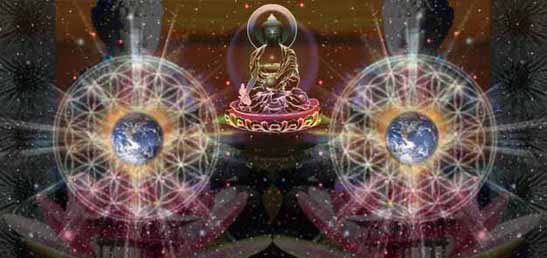
Goddess of the Compassion and Mercy

Goddess of the Compassion and Mercy
For centuries, Kuan Yin has epitomized the great ideal of Mahayana Buddhism in her role as "bodhisattva (Chinese "p'u-sa)--literally "a being of Bodhi, or enlightenment," who is destined to become a Buddha but has foregone the bliss of Nirvana with a vow to save all children of God.
Quan Yin carries the Goddess and Divine Mother aspect of Buddhism. The same Goddess and Divine energy carried by the Virgin Mary in Christianity. In the Egyptian mysteries it is carried by Isis. In Hinduism it is carried by Shakti, wife of Vishnu, by Parvarti, wife of Shiva, by Radha, wife of Krishna, and by Sita, wife of Rama.
Quan Yin's name is a translation of the Sanskrit name of her chief progenitor which is Avalokitesvara, also known as Avalokita. In its proper form it is Kuanshih Yin, which means "She who harkens to the cries of the world."
In Korea, Japan, and China she is called Quan Yin. She is a celestial bodhisattva and an ascended master. One of her jobs in the celestial spheres is to sit on the board of the Lord of Karma.
Buddhist mythology tells of Avalokitesvara's being born from a ray of light that sprang from Amitabha Buddha's right eye. He immediately said, "Om Mane Padme Hum". This is one of the mantras by which he can be invoked in Buddhist tradition.
Avalokitesvara came to be known by most Tibetans as Buddha's earthly representation and as chief guardian of the dharma (doctrine) until the advent of Maitreya Buddha.
Avalokitesvara and Quan Yin are embodiments of compassion.
She is roughly equivalent to Green Tara in Tibetan Buddhism.
In Tibetan Buddhism Quan Yin is seen in her male form as Avalokitesvara. Some feel that the current Dali Lama is an incarnation of Avalokitesvara. It is thought that the female form of Avalokitesvara, Quan Yin, originated in the twelfth or thirteenth century in both China and Japan.
The Saddharma Pundarika Sutra affirms that Avalokitesvara had 357 incarnations.

Quan Yin is one of the most universally beloved of deities in the Buddhist tradition. Also known as Kuan Yin, Quan'Am (Vietnam), Kannon (Japan), and Kanin (Bali), She is the embodiment of compassionate loving kindness. As the Bodhisattva of Compassion, She hears the cries of all beings. Quan Yin enjoys a strong resonance with the Christian Mary, the Mother of Jesus, and the Tibetan goddess Tara.
In many images She is depicted carrying the pearls of illumination. Often Quan Yin is shown pouring a stream of healing water, the "Water of Life," from a small vase. With this water devotees and all living things are blessed with physical and spiritual peace. She holds a sheaf of ripe rice or a bowl of rice seed as a metaphor for fertility and sustenance. The dragon, an ancient symbol for high spirituality, wisdom, strength, and divine powers of transformation, is a common motif found in combination with the Goddess of Mercy.
Sometimes Kuan Yin is represented as a many armed figure, with each hand either containing a different cosmic symbol or expressing a specific ritual position, or mudra. This characterizes the Goddess as the source and sustenance of all things. Her cupped hands often form the Yoni Mudra, symbolizing the womb as the door for entry to this world through the universal female principle.
Quan Yin, as a true Enlightened One, or Bodhisattva, vowed to remain in the earthly realms and not enter the heavenly worlds until all other living things have completed their own enlightenment and thus become liberated from the pain-filled cycle of birth, death, and rebirth.
There are numerous legends that recount the miracles which Quan Yin performs to help those who call on Her. Like Artemis, She is a virgin Goddess who protects women, offers them a religious life as an alternative to marriage, and grants children to those who desire them.
The Goddess of Mercy is unique among the heavenly hierarchy in that She is so utterly free from pride or vengefulness that She remains reluctant to punish even those to whom a severe lesson might be appropriate. Individuals who could be sentenced to dreadful penance in other systems can attain rebirth and renewal by simply calling upon Her graces with utter and absolute sincerity. It is said that, even for one kneeling beneath the executioner's sword already raised to strike, a single heartfelt cry to Bodhisattva Quan Yin will cause the blade to fall shattered to the ground.
The many stories and anecdotes featuring this Goddess serve to convey the idea of an enlightened being who embodies the attributes of an all pervasive, all consuming, unwavering loving compassion and who is accessible to everyone. Quan Yin counsels us by Her actions to cultivate within ourselves those particular refined qualities that all beings are said to naturally possess in some vestigial form.
Contemplating the Goddess of Mercy involves little dogma or ritual. The simplicity of this gentle being and Her standards tends to lead Her devotees towards becoming more compassionate and loving themselves. A deep sense of service to all fellow beings naturally follows any devotion to the Goddess.
The name Kuan Shih Yin, as she is often called, means literally "the one who regards, looks on, or hears the sounds of the world." According to legend, Kuan Yin was about to enter heaven but paused on the threshold as the cries of the world reached her ears.
Scholars believe that the Buddhist monk and translator Kumarajiva was the first to refer to the female form of Kuan Yin in his Chinese translation of the Lotus Sutra in 406 A.D. Of the thirty-three appearances of the bodhisattva referred to in his translation, seven are female. (Devoted Chinese and Japanese Buddhists have since come to associate the number thirty-three with Kuan Yin.)
Although Kuan Yin was still being portrayed as a male as late as the tenth century, with the introduction of Tantric Buddhism into China in the eighth century during the T'ang dynasty, the image of the celestial bodhisattva as a beautiful white-robed goddess was predominant and the devotional cult surrounding her became increasingly popular. By the ninth century there was a statue of Kuan Yin in every Buddhist monastery in China.
Despite the controversy over the origins of Kuan Yin as a feminine being, the depiction of a bodhisattva as both 'god' and 'goddess' is not inconsistent with Buddhist doctrine. The scriptures explain that a bodhisattva has the power to embody in any form--male, female, child, even animal depending on the type of being he is seeking to save. As the Lotus Sutra relates, the bodhisattva Kuan Shih Yin, "by resort to a variety of shapes, travels in the world, conveying the beings to salvation."
The twelfth-century legend of the Buddhist saint Miao Shan, the Chinese princess who lived in about 700 B.C. and is widely believed to have been Kuan Yin, reinforced the image of the bodhisattva as a female. During the twelfth century Buddhist monks settled on P'u-t'o Shan--the sacred island-mountain in the Chusan Archipelago off the coast of Chekiang where Miao Shan is said to have lived for nine years, healing and saving sailors from shipwreck--and devotion to Kuan Yin spread throughout northern China.
This picturesque island became the chief center of worship of the compassionate Saviouress; crowds of pilgrims would journey from the remotest places in China and even from Manchuria, Mongolia and Tibet to attend stately services there. At one time there were more than a hundred temples on the island and over one thousand monks. The lore surrounding P'u-t'o island recounts numerous appearances and miracles performed by Kuan Yin, who, it is believed, reveals herself to the faithful in a certain cave on the island.
In the Pure Land sect of Buddhism, Kuan Yin forms part of a ruling triad that is often depicted in temples and is a popular theme in Buddhist art. In the center is the Buddha of Boundless Light, Amitabha (Chinese, A-mi-t'o Fo; Japanese, Amida). To his right is the bodhisattva of strength or power, Mahasthamaprapta, and to his left is Kuan Yin, personifying his endless mercy.
In Buddhist theology Kuan Yin is sometimes depicted as the captain of the "Bark of Salvation," guiding souls to Amitabha's Western Paradise, or Pure Land--the land of bliss where souls may be reborn to receive continued instruction toward the goal of enlightenment and perfection. The journey to Pure Land is frequently represented in woodcuts showing boats full of Amitabha's followers under Kuan Yin's captainship.
Amitabha, a beloved figure in the eyes of Buddhists desiring to be reborn in his Western Paradise and to obtain freedom from the wheel of rebirth, is said to be, in a mystical or spiritual sense, the father of Kuan Yin. Legends of the Mahayana School recount that Avalokitesvara was 'born' from a ray of white light which Amitabha emitted from his right eye as he was lost in ecstasy.
Thus Avalokitesvara, or Kuan Yin, is regarded as the "reflex" of Amitabha'a further emanation or embodiment of "maha karuna (great compassion), the quality which Amitabha himself embodies in the highest sense. Many figures of Kuan Yin can be identified by the presence of a small image of Amitabha in her crown. It is believed that as the merciful redemptress Kuan Yin expresses Amitabha's compassion in a more direct and personal way and prayers to her are answered more quickly.
The iconography of Kuan Yin depicts her in many forms, each one revealing a unique aspect of her merciful presence. As the sublime Goddess of Mercy whose beauty, grace and compassion have come to represent the ideal of womanhood in the East, she is frequently portrayed as a slender woman in flowing white robes who carries in her left hand a white lotus, symbol of purity. Ornaments may adorn her form, symbolizing her attainment as a bodhisattva, or she may be pictured without them as a sign of her great virtue.
Kuan Yin's presence is widespread through her images as the "bestower of children" which are found in homes and temples. A great white veil covers her entire form and she may be seated on a lotus. She is often portrayed with a child in her arms, near her feet, or on her knees, or with several children about her. In this role, she is also referred to as the "white-robed honored one." Sometimes to her right and left are her two attendants, Shan-ts'ai Tung-tsi, the "young man of excellent capacities," and Lung-wang Nu, the "daughter of the Dragon-king."
Kuan Yin is also known as patron bodhisattva of P'u-t'o Shan, mistress of the Southern Sea and patroness of fishermen. As such she is shown crossing the sea seated or standing on a lotus or with her feet on the head of a dragon.
Like Avalokitesvara she is also depicted with a thousand arms and varying numbers of eyes, hands and heads, sometimes with an eye in the palm of each hand, and is commonly called "the thousand-arms, thousand-eyes" bodhisattva. In this form she represents the omnipresent mother, looking in all directions simultaneously, sensing the afflictions of humanity and extending her many arms to alleviate them with infinite expressions of her mercy.
Symbols characteristically associated with Kuan Yin are a willow branch, with which she sprinkles the divine nectar of life; a precious vase symbolizing the nectar of compassion and wisdom, the hallmarks of a bodhisattva; a dove, representing fecundity; a book or scroll of prayers which she holds in her hand, representing the dharma (teaching) of the Buddha or the sutra (Buddhist text) which Miao Shan is said to have constantly recited; and a rosary adorning her neck with which she calls upon the Buddha's for succor.
Images of Avalokitesvara often show him holding a rosary; descriptions of his birth say he was born with a white crystal rosary in his right hand and a white lotus in his left. It is taught that the beads represent all living beings and the turning of the beads symbolizes that Avalokitesvara is leading them out of their state of misery and repeated rounds of rebirth into nirvana.
Today Kuan Yin is worshipped by Taoists as well as Mahayana Buddhists--especially in Taiwan, Japan, Korea and once again in her homeland of China, where the practice of Buddhism had been suppressed by the Communists during the Cultural Revolution (1966-69).
She is the protectress of women, sailors, merchants, craftsmen, and those under criminal prosecution, and is invoked particularly by those desiring progeny. Beloved as a mother figure and divine woman who is very close to the daily affairs of her devotees, Kuan Yin's role as Buddhist Madonna has been compared to that of Mary the mother of Jesus in the West. It is in truth the same soul. Read more ..

Guatama Buddha

Buddhism

Wesak